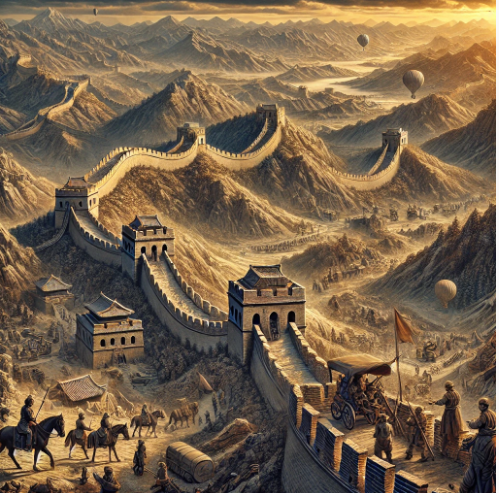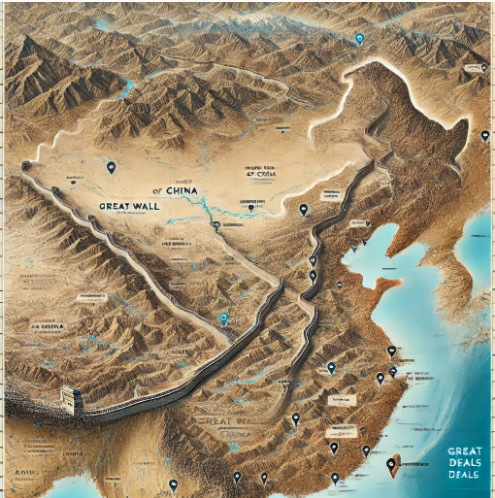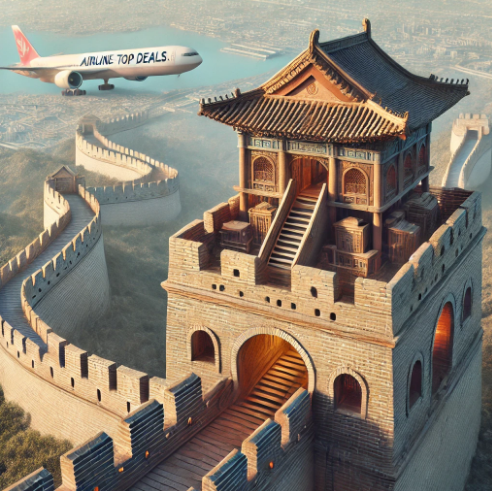10 interesting things you didn’t know about the Great Wall of China
The Great Wall of China is one of the most famous and awe-inspiring structures in the world, symbolizing China’s rich history, strength, and resilience. Stretching for 21,000 kilometers (13,000 miles), it is the longest man-made structure ever built. Built over many centuries, the wall served as a defensive barrier against invasions by northern nomadic tribes and played a key role in shaping Chinese history.
A UNESCO World Heritage Site, the wall attracts millions of visitors each year, offering breathtaking views and a glimpse into China’s ancient past. With its massive stone fortresses, watchtowers, and hidden passages, the wall remains one of the most impressive engineering feats of all time.
The Great Wall of China is one of the most famous and historically significant structures in the world. Built over 2,000 years ago, it stretches for some 21,196 kilometers (13,171 miles) across northern China, making it the longest man-made structure ever created. Originally built to protect Chinese dynasties from invasions, the wall is an architectural marvel that features fortresses, watchtowers, and secret passages.

Today, it stands as a symbol of China’s rich history and cultural heritage. A UNESCO World Heritage Site, the wall attracts millions of tourists each year, who come to see its grandeur and explore its ancient routes. Its breathtaking views and historical significance make it one of the most famous landmarks in the world.
The Great Wall of China holds immense historical significance as one of the greatest engineering feats in human history. Originally built to protect Chinese dynasties from invasions, it has also served as a symbol of power, unity, and determination throughout China’s past. The wall reflects the strategic military advances of ancient China, showcasing innovative defense mechanisms such as watchtowers, beacons, and fortifications.
For travelers, the wall offers the opportunity to walk its ancient paths, admire breathtaking landscapes, and experience a piece of history firsthand. Historians are fascinated by its role in shaping China’s political and military strategies, while researchers study its construction methods, materials, and preservation challenges. As a UNESCO World Heritage Site, the Great Wall continues to fascinate people around the world, symbolizing the resilience, cultural heritage, and incredible achievements of ancient civilizations.
This blog reveals 10 interesting little-known facts about the Great Wall of China, much more than most people already know. While many people recognize it as a massive ancient structure built for defense, there are many hidden stories, surprising legends, and unique details that make the wall even more interesting. From its true length and building materials to secret passages and debunking common myths, these facts will give readers a deeper understanding of this historic wonder. Whether you’re a history buff, traveler, or just curious, these insights will change the way you view the Great Wall of China!
10 Fascinating Facts About the Great Wall of China You Didn’t Know
The Great Wall of China stands as one of the most remarkable man-made wonders in the world, stretching across rugged terrain and showcasing centuries of history. While many travelers recognize its grandeur, there are countless intriguing facts that make it even more fascinating. If you’re planning to explore this historic marvel, check out Airline-Topdeals.com for budget-friendly flights and travel deals. Here are 10 lesser-known yet fascinating facts about the Great Wall of China.
1. The Great Wall Is Not a Single Continuous Structure
Many believe the Wall is one long, unbroken structure, but in reality, it consists of multiple walls and fortifications built by different dynasties over thousands of years.

Contrary to popular belief, the Great Wall of China is not a single, unbroken wall that stretches across the country. Instead, it consists of multiple sections built at different times by different Chinese dynasties over a period of over 2,000 years. Some parts of the wall overlap, while others are separate, depending on the military needs and geographical challenges of the time.
The earliest walls were built as independent fortifications, and later dynasties such as the Ming Dynasty (1368–1644) connected and strengthened several sections. However, even today, gaps remain where natural barriers such as rivers and mountains served as defenses. These disconnected sections highlight the evolution of Chinese military strategies rather than a single, unified structure.
2. It Was Built Over 2,000 Years by Different Dynasties
The earliest constructions began as early as the 7th century BC, with later additions by the Qin, Han, and Ming dynasties, among others.
The construction of the Great Wall of China took over 2,000 years, beginning in the 7th century BC and continuing until the 17th century. It was not built all at once, but was built in different phases by different Chinese dynasties, each adding or strengthening sections to meet their defensive needs.

The Qin Dynasty (221–206 BC) was the first to unite and connect several walls, laying the foundation for what would become the Great Wall. Later, the Han Dynasty (206 BC–220 AD) further extended it to protect against northern invaders. However, the most well-preserved and recognizable sections visible today were built by the Ming Dynasty (1368–1644) using brick, stone, and sophisticated fortifications.
Each dynasty contributed to the expansion and evolution of the wall, which has stood as a testament to Chinese military strategy, engineering skills, and resilience for centuries.
3. The Wall’s Actual Length Is Much Longer Than Expected
While commonly cited at 13,000 miles, new surveys estimate that the entire network of walls, trenches, and natural barriers extends even further.
Many people think of the Great Wall of China as a single long barrier, but its actual length is much longer than many people imagine. According to modern surveys by the State Administration of Cultural Heritage of China, the wall stretches for about 21,196 kilometers (13,171 miles) – much longer than previous estimates.

This total includes not only the main wall, but also branches, moats, watchtowers, and forts built in various terrains, such as mountains, deserts, and grasslands. Over the centuries, various dynasties expanded and rebuilt sections, resulting in a vast defensive network rather than a single, continuous structure.
However, due to erosion, natural disasters, and human activity, parts of the wall have disappeared over time. Nevertheless, the Great Wall remains one of the most impressive engineering feats in history, demonstrating the enormous effort and dedication that went into its construction.
4. Millions of Workers Helped Construct the Wall
Laborers included soldiers, peasants, and even prisoners, with many losing their lives during the challenging construction process.

The construction of the Great Wall of China was a monumental task that required the labor of millions of workers over 2,000 years. This workforce included soldiers, farmers, prisoners, and scholars, many of whom were forced to labor under harsh conditions.
Building the wall was a difficult and dangerous task, as workers had to carry heavy stones, bricks, and other materials over steep mountains and rugged terrain. Many workers lost their lives due to fatigue, harsh weather, and accidents, leading some to refer to the wall as “the longest cemetery on earth.”
Despite these hardships, their efforts amounted to one of the greatest engineering feats in history, leaving behind a structure that stands as a symbol of strength, resilience, and human perseverance.
5. It Was Designed as a Defense System
More than just a barrier, the Wall included watchtowers, fortresses, and signal systems to alert against enemy invasions.

Many people think that the Great Wall of China was designed to completely stop enemy invasions, but its main purpose was actually to slow down attackers and serve as a warning system. The wall was built with watchtowers, forts, and signal systems to detect and delay invasions, which gave Chinese armies time to prepare for defense. In most cases, invaders were still able to breach the wall, but its presence helped protect important trade routes and settlements.
6. The Wall Played a Key Role in the Silk Road Trade
Beyond its military purpose, the Wall facilitated trade and cultural exchange between China and other civilizations.

The Great Wall was not just a long barrier—it contained thousands of watchtowers, forts, and hidden tunnels used for defense and communication. Watchtowers were regularly built to give soldiers a strategic advantage, allowing them to spot enemies from a distance. Secret underground tunnels and passageways were used for quick escapes, troop movements, and surprise counterattacks against invaders.
7. Different Materials Were Used in Various Regions
Depending on the location, builders used stone, wood, rammed earth, and bricks, making each section unique.

The Great Wall was not just a long barrier – it contained thousands of watchtowers, forts, and hidden tunnels used for defense and communication. Watchtowers were regularly built to give soldiers a strategic advantage, allowing them to spot enemies from a distance. Secret underground tunnels and passageways were used for quick escapes, troop movements, and surprise counterattacks against invaders.
8. The Great Wall Can’t Be Seen from Space
Contrary to popular belief, the Wall is too narrow and blends into its surroundings, making it invisible to the naked eye from space.

In addition to being a military defense structure, the Great Wall played a vital role in trade and cultural exchange. It helped protect merchants and traders traveling along the Silk Road, one of the most important trade routes in ancient China. Guard stations along the Wall also served as checkpoints for tax collection and border control, helping Chinese dynasties regulate trade and movement.
9. Some Sections Are Disappearing Due to Erosion
Time and natural elements have taken their toll, and without preservation efforts, parts of the Wall are crumbling.

A common myth about the Great Wall is that it is visible from the moon, but this is not true. Astronauts and scientists confirm that the wall is so narrow and blends into the surrounding landscape, making it almost impossible to see with the naked eye from space. However, it is one of the largest man-made structures on Earth, and satellite images have captured parts of it from orbit.
10. It Offers Some of the Most Breathtaking Views
Stretching across mountains, deserts, and valleys, the Great Wall provides stunning panoramic views for adventurous travelers.
Despite its historical significance, the Great Wall is slowly disappearing due to natural erosion, weather conditions, and human activity. More than 30% of the wall has already been destroyed, and some sections are at risk of collapse. Efforts are underway to preserve and restore key sections, but factors such as urbanization, tourism, and climate change threaten its long-term survival. Conservationists and historians are emphasizing the importance of protecting this iconic landmark for future generations.
Plan Your Great Wall Adventure
Now that you know these incredible facts, why not experience the Great Wall firsthand? Visit Airline-Topdeals.com for exclusive airfare deals and start your journey into history today! For Airline news visit our blog
Also Visit:
